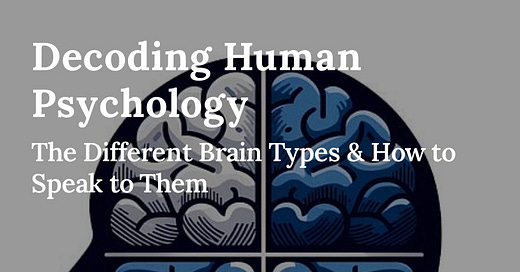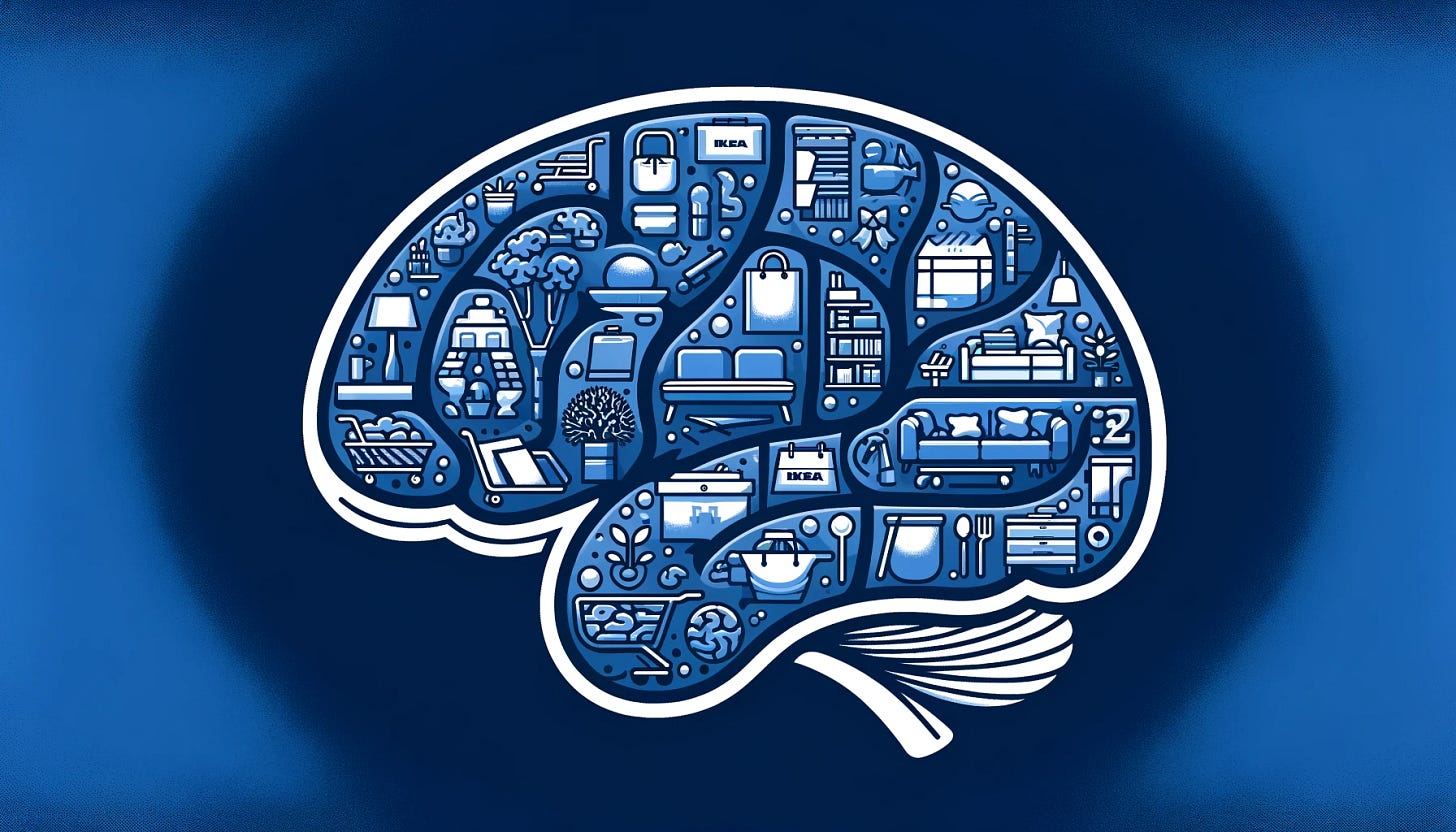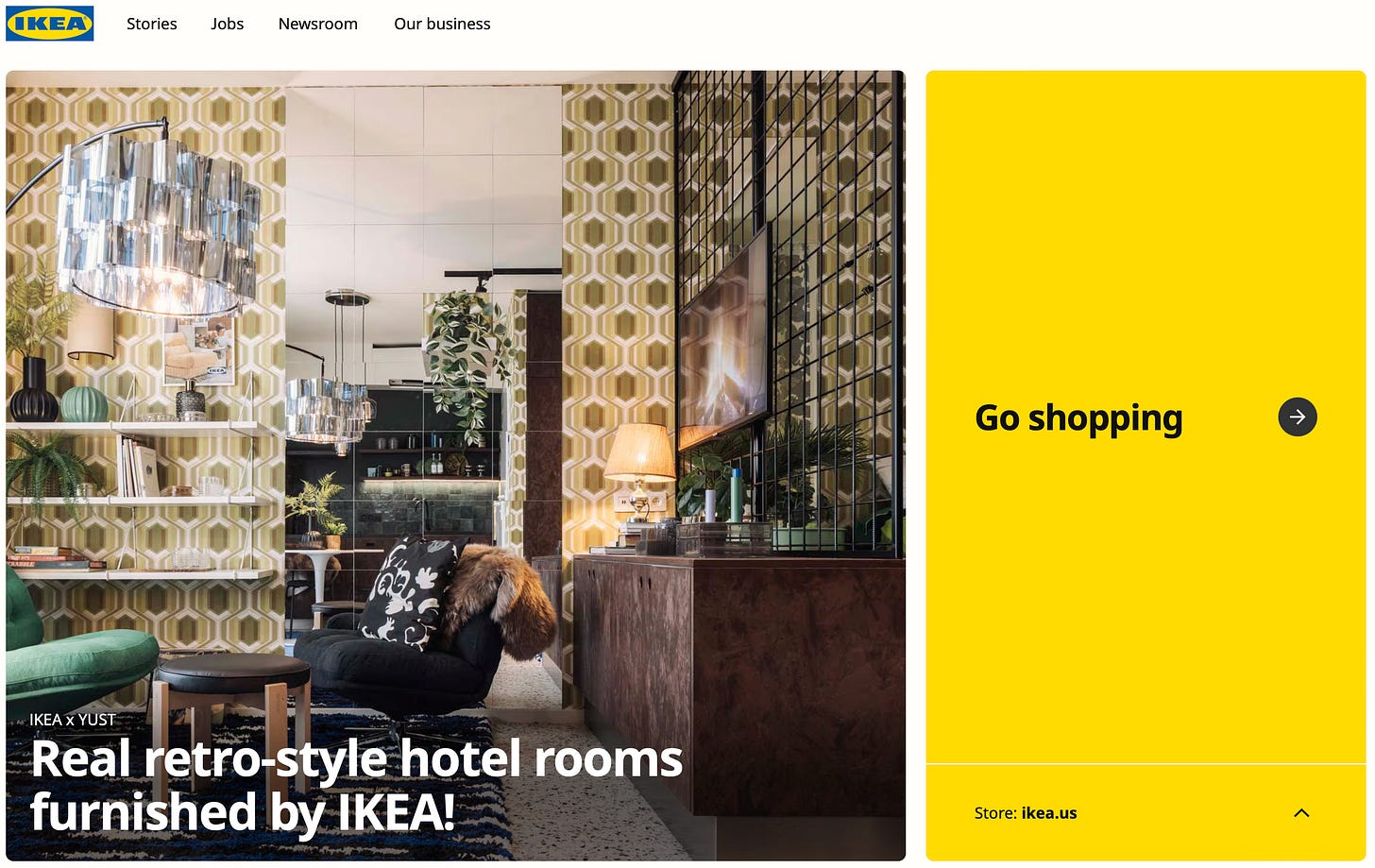(The article voiceover was created with Eleven Labs ai, still in beta. Enjoy my clone prototype full of robotic mispronunciation!) - MD
It's All in Your Head (Literally)
Welcome to the fascinating intersection of neuroscience and marketing! If you thought understanding your in-laws was complicated, try unraveling the mysteries of the human brain to improve your brand strategy.
As we dive into the different brain types, based on major personality theories and cognitive science, let’s leverage this knowledge to speak directly to the inner workings of your audience's minds.
Personality: The Four Quadrants
Personality psychology has given us various models to categorize human behavior, but let’s focus on the one that fits best in our marketing lab coats: the four quadrants derived from popular personality assessments like the Myers-Briggs Type Indicator (MBTI), the Big Five personality traits, and Enneagram.
These models help us slice the personality pie into digestible bites, perfect for crafting targeted marketing strategies.
1. Quadrant I: Openness/Intuition (The Visionaries)
Key Traits: Innovative, Strategic, Imaginative
MBTI: INFP, ENFP, INTJ, ENTJ, INFJ
Big Five: High Openness
Enneagram: Type 4 (Individualist), Type 5 (Investigator), Type 7 (Enthusiast)
Marketing Tip: Appeal to their love for new experiences and ideas. Use visionary language and futuristic concepts.
Studies indicate that individuals high in traits like openness to experience have a heightened activity in brain areas linked to the dopamine system, particularly in regions associated with reward anticipation and novelty seeking. This neurobiological trait makes them more receptive to new and innovative products.
Brand Example: Apple
Application: Apple consistently markets its products as the pinnacle of innovation and design, which appeals directly to Visionaries who crave the new and the next. Their launches often focus on revolutionary features and cutting-edge technology, catering to those who are drawn to novel experiences.
Impact: By continually pushing the envelope and focusing on the future, Apple maintains its brand as a status symbol for those who see themselves as ahead of the curve.
A 2015 study found that people high in openness are 23% more likely to engage with advertisements that feature novel or unique elements than those that do not.
"Dopamine, Novelty, and Engagement: A Neuroscientific Insight into Consumer Behavior," Journal of Consumer Neuroscience, 2015.
2. Quadrant II: Conscientiousness/Judging (The Organizers)
Key Traits: Organized, Dependable, Detail-Oriented
MBTI: ISTJ, ESTJ, ENTJ, INTJ, INFJ
Big Five: High Conscientiousness
Enneagram: Type 1 (Reformer), Type 3 (Achiever), Type 6 (Loyalist)
Marketing Tip: Highlight reliability, efficiency, and precision. Detailed infographics and well-structured offers work wonders.
Individuals high in conscientiousness show greater activation in the prefrontal cortex, the area of the brain responsible for planning and decision-making. This suggests they respond positively to marketing that highlights structured benefits and efficiency.
Brand Example: Ikea
Application: Ikea uses a highly structured approach in its marketing, highlighting the functionality and efficiency of its products. Their marketing materials often feature well-organized spaces and stress the practicality and affordability of their offerings, appealing to the Organizer's love for order and dependability.
Impact: Ikea’s approach reassures Organizers that they are making a sensible, well-planned choice, which enhances customer satisfaction and loyalty.
According to a 2017 study, campaigns that clearly outline product benefits and provide detailed specifications can increase purchase intent by up to 30% among high conscientiousness consumers.
"Cognitive Processing and Brand Choice: Understanding the Prefrontal Cortex," Neuromarketing Science & Business Association, 2017.
3. Quadrant III: Extraversion/Feeling (The Communicators)
Key Traits: Outgoing, Empathetic, Persuasive
MBTI: ENFP, ENFJ, ESFP, ESFJ, ESTP
Big Five: High Extraversion
Enneagram: Type 2 (Helper), Type 3 (Achiever), Type 7 (Enthusiast)
Marketing Tip: Engage with stories that resonate emotionally and socially. Create campaigns that encourage interaction and community involvement.
Extraverts are typically more responsive to social cues and show increased activity in areas of the brain associated with sensory and emotional processing when exposed to social stimuli. This makes them ideal targets for campaigns focused on social interaction and community.
Brand Example: Coca-Cola
Application: Coca-Cola excels in creating campaigns that evoke feelings of happiness, togetherness, and good vibes, which are irresistible to Communicators. Their ads often feature groups of people enjoying life together, emphasizing shared experiences.
Impact: These emotionally charged campaigns create a strong emotional bond between the brand and its consumers, making Coca-Cola synonymous with positive experiences and social gatherings.
Extraverts are 50% more likely to share content on social media that includes social themes or community involvement, according to a 2019 social media analysis.
"Social Brain Dynamics and Brand Sharing," Social Neuroscience Journal, 2019.
4. Quadrant IV: Agreeableness/Perceiving (The Harmonizers)
Key Traits: Cooperative, Flexible, Patient
MBTI: ISFP, INFP, ESFP, ENFP, ISFJ
Big Five: High Agreeableness
Enneagram: Type 2 (Helper), Type 9 (Peacemaker), Type 4 (Individualist)
Marketing Tip: Emphasize harmony, flexibility in use, and the value of peace of mind. Stress community and shared values.
Agreeable individuals tend to have more developed areas of the brain involved in processing empathy and considering others' perspectives. Marketing that emphasizes ethical practices and collective benefits tends to resonate deeply with this group.
Brand Example: Patagonia
Application: Patagonia’s marketing strategies focus on sustainability and environmental responsibility, which resonates deeply with Harmonizers. They emphasize their commitment to ethical practices and conservation, aligning with the Harmonizers' values of cooperation and community welfare.
Impact: By aligning their brand values with those of their consumers, Patagonia has built a loyal community of customers who feel that their purchases support a greater good.
A survey in 2020 found that 65% of consumers high in agreeableness preferred buying from brands that have strong corporate social responsibility messages.
"Empathy and Ethical Brand Engagement," Journal of Brand Management, 2020.
Understanding these quadrants through the lens of neuroscience isn't just about knowing who prefers coffee over tea. It's about predicting and influencing how different brain types process information, make decisions, and ultimately, how they connect with your brand.
Aligning your marketing strategy with the psychological and neurological profiles of your target audience doesn’t just increase engagement—it ensures your brand becomes a brain-friendly favorite.
Ready to leverage neuroscience in your branding strategy?
Message me to explore how we can tune your message to resonate with the specific brain types of your audience. Remember, in marketing as in neuroscience, it's all about making the right connections.
And if you're itching for even more insights, head over to my detailed article, "There is no secret, it's just Brand Strategy" where I delve deeper into the foundations of brand strategy.















